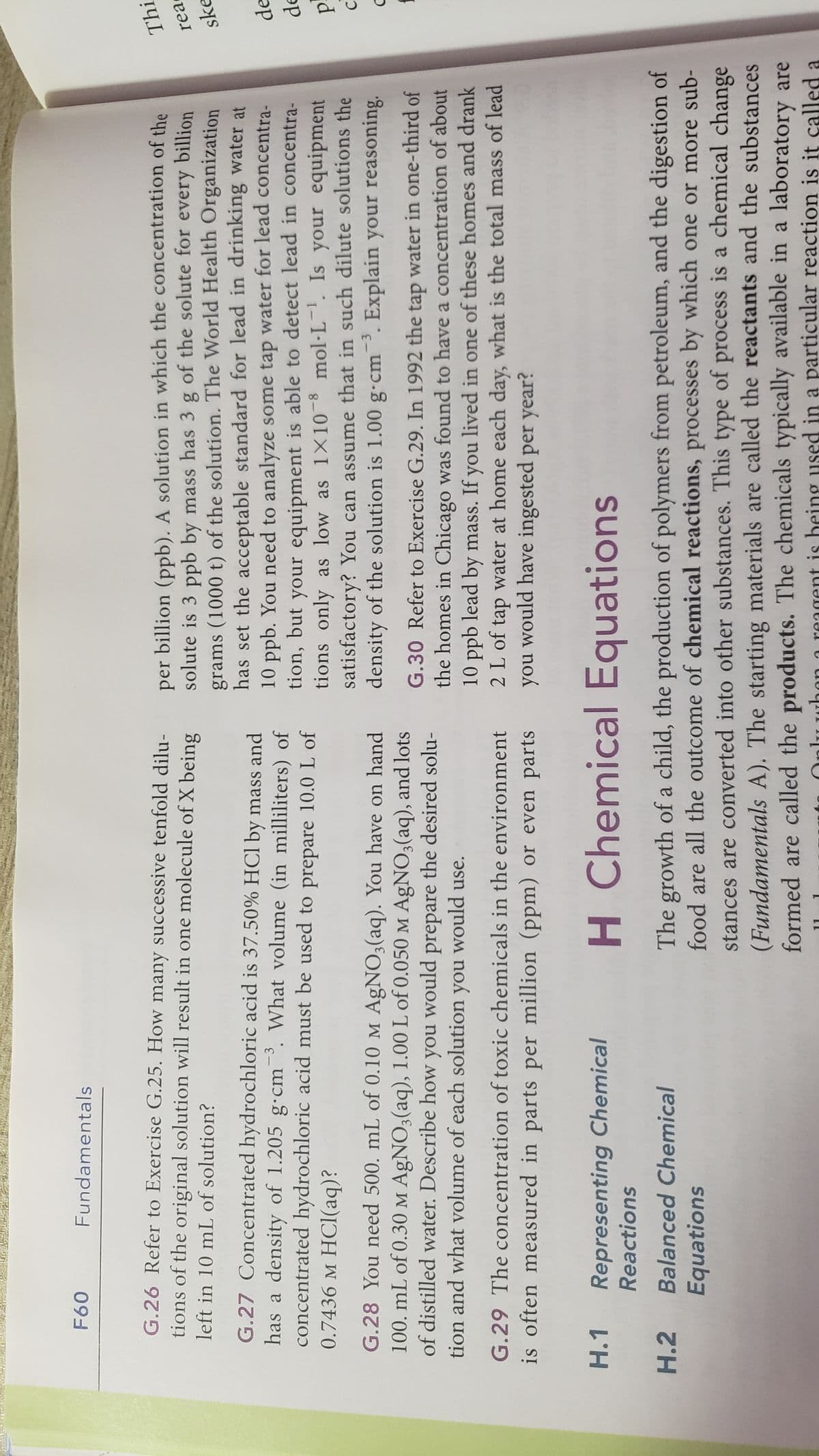Chemistry: An Atoms First Approach
2nd Edition
ISBN:9781305079243
Author:Steven S. Zumdahl, Susan A. Zumdahl
Publisher:Steven S. Zumdahl, Susan A. Zumdahl
Chapter6: Types Of Chemical Reactions And Solution Stoichiometry
Section: Chapter Questions
Problem 123CP: The units of parts per million (ppm) and parts per billion (ppb) are commonly used by environmental...
Related questions
Question
How do I explain my reasoning for G29?

Transcribed Image Text:F60
Fundamentals
G.26 Refer to Exercise G.25. How many successive tenfold dilu-
tions of the original solution will result in one molecule of X being
left in 10 mL of solution?
G.27 Concentrated hydrochloric acid is 37.50% HCl by mass and
has a density of 1.205 g-cm3. What volume (in milliliters) of
concentrated hydrochloric acid must be used to prepare 10.0 L of
0.7436 M HCl(aq)?
G.28 You need 500. mL of 0.10 M AgNO3(aq). You have on hand
100. mL of 0.30 M AgNO3(aq), 1.00 L of 0.050 M AgNO3(aq), and lots
of distilled water. Describe how you would prepare the desired solu-
you would use.
tion and what volume of each solution
G.29 The concentration of toxic chemicals in the environment
is often measured in parts per million (ppm) or even parts
H.1 Representing Chemical
Reactions
H.2 Balanced Chemical
Equations
per billion (ppb). A solution in which the concentration of the
solute is 3 ppb by mass has 3 g of the solute for every billion
grams (1000 t) of the solution. The World Health Organization
has set the acceptable standard for lead in drinking water at
10 ppb. You need to analyze some tap water for lead concentra-
tion, but your equipment is able to detect lead in concentra-
tions only as low as 1×108 mol-L¹. Is your equipment
satisfactory? You can assume that in such dilute solutions the
density of the solution is 1.00 g-cm3. Explain your reasoning.
G.30 Refer to Exercise G.29. In 1992 the tap water in one-third of
the homes in Chicago was found to have a concentration of about
10 ppb lead by mass. If you lived in one of these homes and drank
2 L of tap water at home each day, what is the total mass of lead
you would have ingested per year?
H Chemical Equations
The growth of a child, the production of polymers from petroleum, and the digestion of
food are all the outcome of chemical reactions, processes by which one or more sub-
stances are converted into other substances. This type of process is a chemical change
(Fundamentals A). The starting materials are called the reactants and the substances
formed are called the products. The chemicals typically available in a laboratory are
used in a particular reaction is it called a
Thi
rea
ske
de
de
p
f
Expert Solution
This question has been solved!
Explore an expertly crafted, step-by-step solution for a thorough understanding of key concepts.
This is a popular solution!
Trending now
This is a popular solution!
Step by step
Solved in 4 steps

Knowledge Booster
Learn more about
Need a deep-dive on the concept behind this application? Look no further. Learn more about this topic, chemistry and related others by exploring similar questions and additional content below.Recommended textbooks for you

Chemistry: An Atoms First Approach
Chemistry
ISBN:
9781305079243
Author:
Steven S. Zumdahl, Susan A. Zumdahl
Publisher:
Cengage Learning


Chemistry
Chemistry
ISBN:
9781305957404
Author:
Steven S. Zumdahl, Susan A. Zumdahl, Donald J. DeCoste
Publisher:
Cengage Learning

Chemistry: An Atoms First Approach
Chemistry
ISBN:
9781305079243
Author:
Steven S. Zumdahl, Susan A. Zumdahl
Publisher:
Cengage Learning


Chemistry
Chemistry
ISBN:
9781305957404
Author:
Steven S. Zumdahl, Susan A. Zumdahl, Donald J. DeCoste
Publisher:
Cengage Learning

Chemistry: Principles and Practice
Chemistry
ISBN:
9780534420123
Author:
Daniel L. Reger, Scott R. Goode, David W. Ball, Edward Mercer
Publisher:
Cengage Learning

Principles of Modern Chemistry
Chemistry
ISBN:
9781305079113
Author:
David W. Oxtoby, H. Pat Gillis, Laurie J. Butler
Publisher:
Cengage Learning

Introductory Chemistry: A Foundation
Chemistry
ISBN:
9781337399425
Author:
Steven S. Zumdahl, Donald J. DeCoste
Publisher:
Cengage Learning